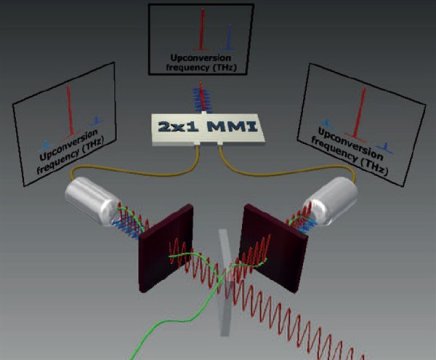
An ultrahigh speed, wireless
communication network using THz instead of GHz frequencies is now one step
closer. Researchers have shown that it is possible to effectively transmit
signal waves with THz frequencies through the existing fiber optic network.
HD television, big data, the internet of things and social media have considerably increased the data rate of our wireless communication network, and continue to do so. An obvious way to facilitate this network growth is to use terahertz frequencies (THz, 1012 Hertz) with high-speed data rates of up to 100 Gbit/s. Current wireless data communication systems operate at an average speed of 100Mbi/s using microwave frequencies around one gigahertz (GHz, 109 Hertz). For instance: GPS systems work with 1,3 GHz frequencies, wifi with 2,4 and 5 GHz, and your microwave with 2,45 GHz. In the search for free frequencies, the unexplored THz area is of great interest.
Distortion of terahertz signals
For wireless THz surfing on the Internet, it is necessary to connect THz wireless stations to the worldwide fiber optic network. However, existing microwave techniques do not operate at THz frequencies. "THz is a difficult frequency region, because it is both electronic and optic at the same time," FELIX researcher Giel Berden explains. "It is too low for normal optics, and too high for standard electronics." Moreover, THz signal waves in the fiber optic network are scrambled, because standard modulation of laser light generates two sidebands (colours) that interfere with one another. Optical Single Side Band (OSSB) is a method to prevent this scrambling of information by selectively extinguishing one sideband.
Special beam splitter
Scientists at Radboud University's FELIX Laboratory developed an OSSB modulator that enables wireless THz waves to be transmitted unperturbed through the fiber network. First author Afric Meijer explains: "With a specially designed beam splitter that splits both the THz waves and the infrared laser light in half, one of the two sidebands is reduced by a factor of over sixty, while the other sideband's intensity increases significantly." The special modulator does not contain any moving parts or colour filters, and operates over an ultra-wide bandwidth from 0.3 to 1 THz.
The THz OSSB modulator is a by-product of the research by TeraOptronics on the THz laser FLARE (Free-electron Laser for Advanced spectroscopy and high-Resolution Experiments) at Radboud University. "The apparatus to determine the colour of FLARE's laser light was exactly what was needed to observe THz OSSB," Meijer explains. "Both the special THz laser FLARE and Afric's interest to expand communication with THz frequencies were imperative to make an impact in this field that was new to us," says co-author Wim van de Zande, currently Director of Research at ASML.
Opportunities for ultra HD, virtual reality and big data
As THz signals in the air are strongly absorbed by water vapour, wireless THz communication will mostly be used for relatively short distances. Meijer: "Our THz OSSB modulator allows us to use the existing fiber optic network. Ultra HD and Virtual Reality images can be received or transmitted wirelessly through a THz link, just like the petabytes of data in research institutes and hospitals." Berden: "This publication is a proof of principle. To actually use the technique requires a couple of additional steps, for instance scaling down the design for microfabrication and improvements in efficiency. Our hope is that this idea will be further developed by the industry."

 Previous page
Previous page Back to top
Back to top







